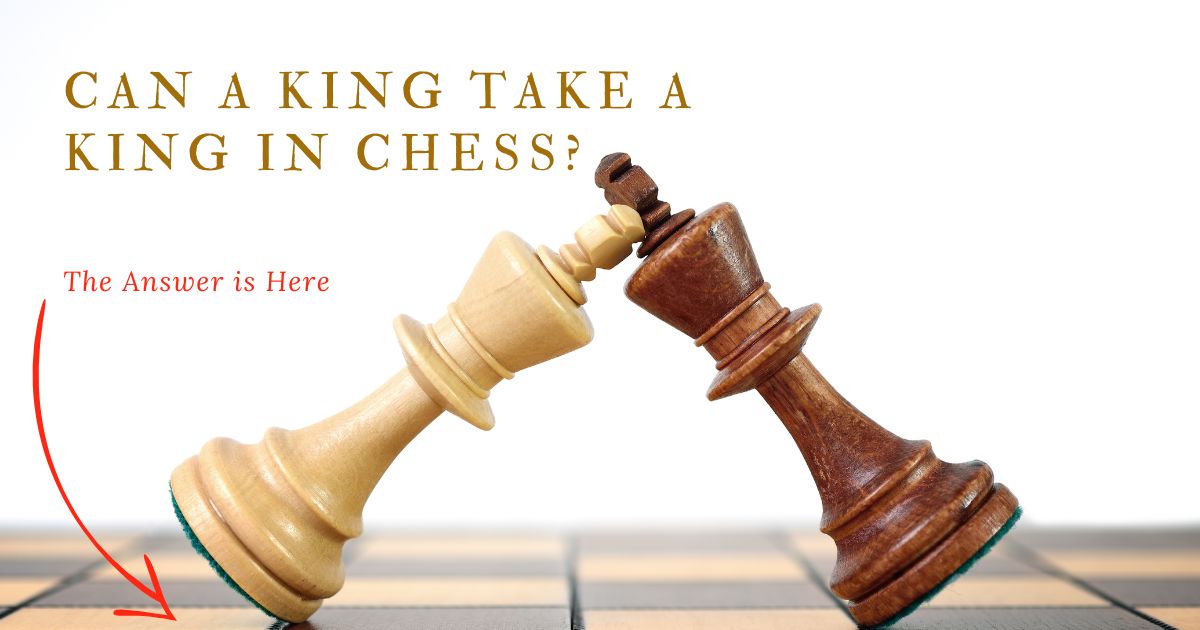The King Chess Piece
Many wonder, can a king take a king in chess? The king is one of the most important pieces in the game of chess. It can cast or move to any of the adjacent squares. The king can advance one space at a time.
When a player’s king is at risk of being captive, the player has their king “under check.” The player is responsible for removing the threat during the following action.

Can a King Take a King in Chess?
In chess, the king is in charge of the entire army. It is your objective to capture your opponent’s king. This means that you must always protect your king. Similar to ancient times, your king’s death denotes your enemy’s victory. Suppose the game’s objective is to trap your opponent’s king.
Does this suggest that an enemy piece may succeed in doing so? or even better, can a king win a chess game against another king? You are correct if you replied “no.” Because the goal is to checkmate your opponent by trapping their king, you cannot take a king or any other hostile piece in chess.
Let’s look at the restriction against capturing an enemy monarch and talk about what to do if such a situation ever arises. The king should never stay on or move to a square where an enemy piece might capture him.
We would refer to this as an “illegal maneuver.” Two kings cannot stand close because each king controls all eight squares around it. You have options if your opponent makes illegal movements or places his king on a vulnerable square. The ideal suggestion is:
Request that he reverse the unlawful action. You must stop the clock and inform your adversary that his action was improper. It does not necessarily indicate that your opponent has already lost the game just because he made a play against the rules. It is sufficient for him to undo the improper action and continue from where he left off.
Conversely, players may suffer various consequences if they make an illegal move in a chess game. The following are the effects of engaging in unlawful behavior:
Making an unlawful move will give your opponent more time if both players have less than five minutes remaining and the game is close. The particular steps you should take in this situation if your opponent makes an illegal move are as follows:
- Pause the time and request the arbitrator.
- You must let the referee know where your opponent violated the rules.
- Depending on the circumstance, the referee should grant you an additional two to three minutes of clock time. (He should rely on his judgment)
- The opponent must forego the unlawful move and execute the right move.
You can forfeit the game if the second penalty does not right away. If you commit two illegal actions within the same match, you may lose the game, albeit this isn’t always the case. The arbitrator shall be able to permit up to three illegal moves at any time.
This rule must always be in mind when participating in chess events. Don’t hesitate to contact your Arbiter before the game begins if you have any questions about the overall amount of handicaps you will use.
There won’t be a penalty for the first unlawful move made if the timer indicates that more than five minutes have gone since the beginning of the game. In most circumstances, an arbiter is unnecessary in this case. If you believe your opponent made a genuine mistake in their move, you can politely request that they reverse it.
Now that we know what defines an illegal move and what to do if the king mistakenly steps on one of the threatened squares, let’s dive into some frequently asked questions. The king will always need assistance to complete a checkmating move that ends the game. If you still have any supporting pieces, use them to your advantage.
Even while a king cannot physically touch another king, if placed carefully, it can help “push” the adversary into a corner.
In chess, the potential of capturing one of your opponent’s pieces is an “attack.” Every piece in a chess game, even the king, is capable of making an attack. The king, however, cannot assault a queen or another king; he may only attack a pawn, knight, bishop, or rook. Read our article and find out the Knight Moves in Chess.
The opposing king and queen control every square around them, making it hard for a king to approach them close enough to launch an attack. Similarly, a king cannot enter a square under an enemy king’s control.
The king can still win the game by delivering a check when it is close enough to the opponent’s queen, even though it cannot directly attack the queen (attack the king). Given his current position, the king is in a place to capture the Queen with his subsequent move.
The king captures pieces in the same manner that he moves. He can take any hostile piece that is close to him.
Can any Other Pieces Take a King in Chess?
The simple answer to this question is “no,” but the more precise response is “you cannot.” You win chess games by trapping the opposing player’s king rather than capturing it. The game ends when your opponent’s king can no longer escape an attack because it has nowhere else to go.
It is against the rules to move the king to a position where an enemy piece could seize him because the game’s object is to take possession of the king. The monarch must, however, remain in his present position. Players must first seize possession of their opponent’s king to win a chess game. We refer to this as “checkmating.”
How Does the King Move in Chess?
The king is one of your army’s most mobile pieces, even though it limits its skills. The king can move in any direction, but rooks and bishops move in horizontal and diagonal lines, respectively.
It is one of just two pieces on the board with this ability, the other being the Queen. It shouldn’t be shocking that it can only move one tile simultaneously. You should never underestimate the king’s dexterity, though.
Because of this, trapping a king might be a very difficult task. Their mobility makes it incredibly easy to get away from the location. With the rooks at his disposal, the king can perform a specific maneuver called casting.
With this unusual move, your king may leap over either the rook on the kingside or the rook on the Queenside of the board. If you choose the kingside option, your king will move from e1 to g1 and your rook from h1 to f1.
The king moves from e1 to c1 on the Queenside, while the Rook makes a single move from a1 to d1. With this move, the king is to move from the center of the board to one of its safer corners. It is also very beneficial in encouraging your rooks to participate in the game.
There are a few situations, though, where you can’t take this action. A piece obstructing the way, a king or rook that has already moved, or a king that is in check all prevent you from casting your castle. If an enemy piece is present on any of the squares your king must cross to get there, you cannot build a castle (square f1 for kingside and square d1 for queenside).

A List of King Moves in Chess
The king in chess moves in this way. You can move only one space simultaneously (forward, backward, or sideways). Due to the king’s limited maneuver options, it is essential to protect it from enemy attacks.
When the king is out of control, you can do nothing to change that; a stalemate has occurred. If no moves on the board may take the king out of check, the position is checkmate, and the game is over.
The king can make the next chess moves: The king may advance one square at a time in any direction and enter open spaces.
- The king can move to an opponent’s piece-occupied square and move into that square to capture it as long as the piece has no shield.
- If the king is also under check, it must move to clear the check and is then immobile.
How Many Spaces Can a King Move in Chess?
The king is one chess piece that moves the least quickly overall. When moving around the board, the king frequently only moves one square at a time. There is, however, one noteworthy exception that newcomers need to be aware of. A king may move one square in four directions according to the chess king rules (vertical, horizontal, or diagonal).
The castling move, which consists of a king taking two flat steps in one turn, is one of the few exceptions to this norm. The castling move is the only move in chess that permits two pieces to move simultaneously. The castling move performs with two pieces rather than merely one.
Both the king and one of the rooks are to be present. The castling maneuver is unique, and you can only use it in specific situations. You must first complete each of the following conditions to castle with your king and rook:
- Since the game’s start, neither the king nor the rook has moved (for the whole game).
- If the king is currently under check at the moment of the move, no player may build a castle.
- If the check threat exists in any regions the king progresses through, a player is not permitted to castle.
- You shouldn’t block the king or the rook from moving around the board with other pieces.
Chess King Moves
The knowledge of the king’s movement in chess is essential. The king is a sluggish piece that can only move one square in any direction (forward, backward, to the sides, or diagonally) unless a friendly piece already occupies the square or if moving the king would put him in check.
This means that the king will never be able to sit next to the king who represents the other side. The king has the chance to capture the square and eliminate the enemy piece if an undefended opponent piece is holding it. Except for casting, when it can move two spaces in either direction, the king can only move one.
How does a king move in chess? Whether the king travels forward, backward, or laterally, they can only move one square. The castling move, which the king possesses, is extraordinary. The monarch can never take any action that could put him in danger.
Can the King Capture in Chess?
The king is capable of capturing by making a simple move. The sole rule in the set that prevents the king from capturing other chess pieces is the check rule, which is an exception to this generalization.
The king moves one square horizontally, vertically, or diagonally, taking one square in the same direction. In this way, it captures. Except for the king of the opposing side, the king has the power to capture any enemy piece or pawn. However, only if another piece is not protecting that piece.
In other words, if the king is not going in to check at the time of the move, it may capture.
According to the rules, a king may never move into a check position. When the king is on a square with a challenge from another piece, the game must be in a “check” state.
Therefore, if another piece guards the pawn, you can avoid this move if the king is in a position to take a pawn because the pawn is on the square directly in front of the king, for instance.
Castling is an incredibly potent move that offers the player a considerable advantage even before the action is complete. The king will typically finish the game in a safe location at one of the board’s corners with a row of pawns in front of him. In the end, the rook moves to the center of the board, where it is in a position where one cannot use it easily.
As a result, neither the rook nor the king can capture from where they are right now. When casting, there cannot be any pieces between the rook and the king. In actuality, this is necessary.

The Final Say
Chess would be far less fascinating and enjoyable if the king could not move, as it is a fragile piece. However, this does not imply that the king has unrestricted ability to capture since the restrictions on the king capturing pieces are the same as those on the king moving to a regular square.
In other words, the king must move out of check and cannot move into the review. Therefore, it is not allowed for your king to move if taking another piece would put it in check. If your king cannot move out of check (including by taking another piece), the opposing player has claimed checkmate, and they have won.
The game is a draw if neither player can move their king (including taking another piece) or any other piece on the board without going into check. In chess, you can capture the king despite all of these.
Thanks to the information in this article, you have learned everything there is to know about the king in the game of chess. Wishing you luck in your chess games and other chess-related activities!

